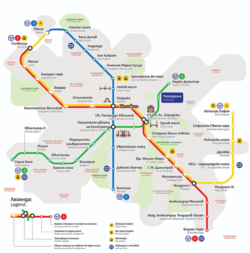Sofia Metro
 |
|||
 |
|||

Map of the Sofia Metro (2016)
|
|||
| Overview | |||
|---|---|---|---|
| Native name | Софийско метро Sofiysko metro |
||
| Owner | City of Sofia | ||
| Locale | Sofia, Bulgaria | ||
| Transit type | Rapid transit | ||
| Number of lines | 2 | ||
| Number of stations | 35 | ||
| Daily ridership | 350,000 (2016) | ||
| Chief executive | Stoyan Bratoev | ||
| Headquarters | 121, Knyaz Boris I str. | ||
| Website | Metropolitan |
||
| Operation | |||
| Began operation | 28 January 1998 | ||
| Operator(s) | Metropolitan-Sofia JSC | ||
| Number of vehicles | 52 | ||
| Technical | |||
| System length | 40.0 km (24.9 mi) | ||
| Track gauge | 1,435 mm (4 ft 8 1⁄2 in) standard gauge | ||
| Electrification | Third rail, 825V DC | ||
| Average speed | 40 km/h (25 mph) | ||
| Top speed | 80 km/h (50 mph) | ||
|
|||
The Sofia Metropolitan (Bulgarian: Софийско метро, translit. Sofiysko metro) is the rapid transit network servicing the Bulgarian capital city Sofia. It began operation on January 28, 1998. As of July 2016[update], the Sofia Metro consists of two interconnected lines, serving 35 stations, with a total route length of 40.0 kilometres (24.9 mi) being among the top 30 of the most extensive European metro systems. The Metro links the densely populated districts of Lyulin – Mladost (Line 1 – Red) and Nadezhda – Lozenets (Line 2 – Blue). Also, since 2 April 2015, Line 1 has been servicing the Sofia Airport.
Planned since the 1960s, construction of the Metro was not officially launched until the late 1990s mainly because the city did not experience an urgent need for an underground system in addition to the stalled construction due to lack of sufficient funding. Another factor was the depth at which the construction works had to be carried out: being one of the oldest cities in Europe, Sofia contains many historical layers underneath its central areas. Evidence of antiquity can be clearly seen at the Serdika Station which exhibits a wealth of unearthed Thracian and Roman ruins and modern architecture. During the construction of the enormous complex of the National Palace of Culture two stations forming part of the then future Line 2 and their connecting tunnels were built.
...
Wikipedia

